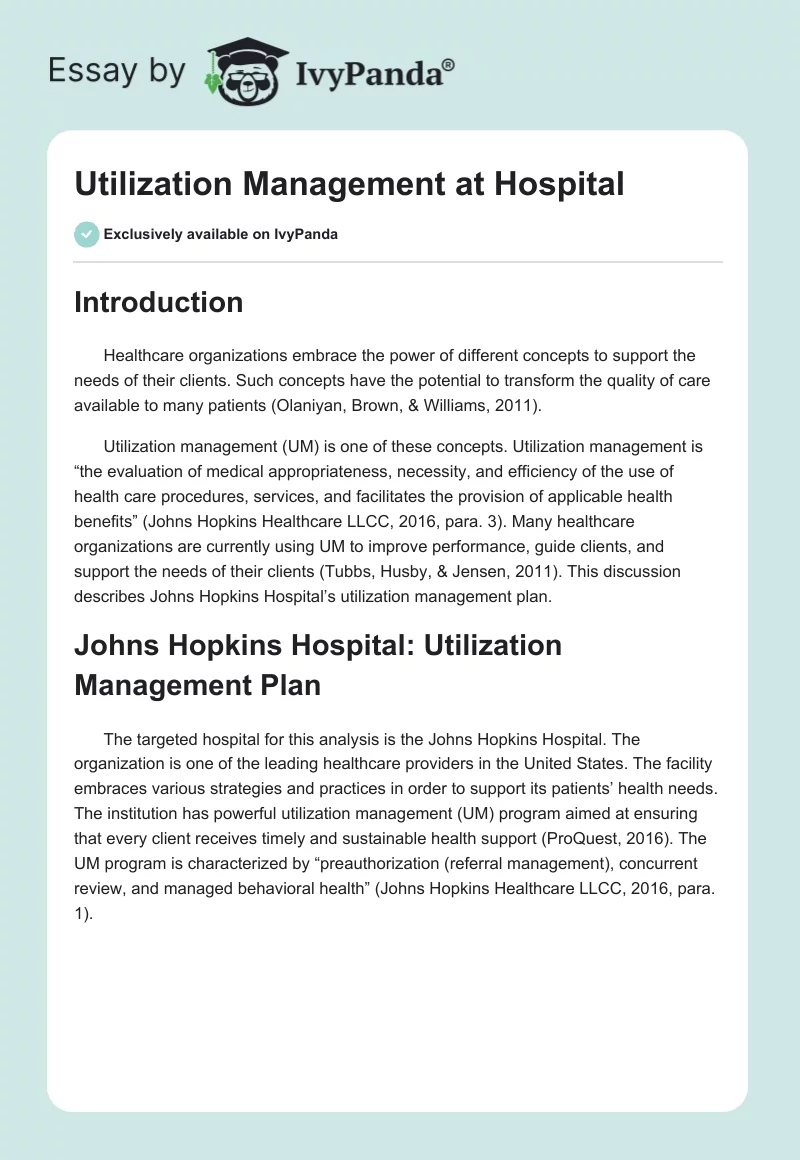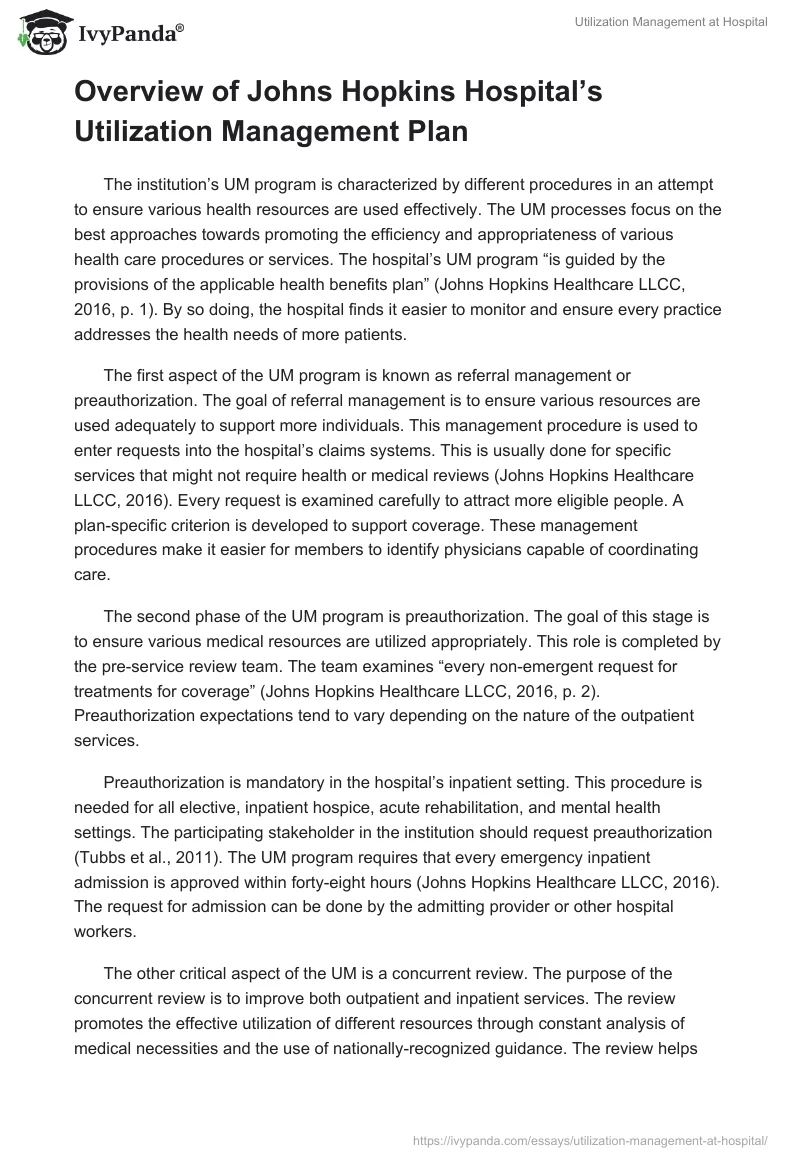Introduction
Healthcare organizations embrace the power of different concepts to support the needs of their clients. Such concepts have the potential to transform the quality of care available to many patients (Olaniyan, Brown, & Williams, 2011).
Utilization management (UM) is one of these concepts. Utilization management is “the evaluation of medical appropriateness, necessity, and efficiency of the use of health care procedures, services, and facilitates the provision of applicable health benefits” (Johns Hopkins Healthcare LLCC, 2016, para. 3). Many healthcare organizations are currently using UM to improve performance, guide clients, and support the needs of their clients (Tubbs, Husby, & Jensen, 2011). This discussion describes Johns Hopkins Hospital’s utilization management plan.
Johns Hopkins Hospital: Utilization Management Plan
The targeted hospital for this analysis is the Johns Hopkins Hospital. The organization is one of the leading healthcare providers in the United States. The facility embraces various strategies and practices in order to support its patients’ health needs. The institution has powerful utilization management (UM) program aimed at ensuring that every client receives timely and sustainable health support (ProQuest, 2016). The UM program is characterized by “preauthorization (referral management), concurrent review, and managed behavioral health” (Johns Hopkins Healthcare LLCC, 2016, para. 1).
Overview of Johns Hopkins Hospital’s Utilization Management Plan
The institution’s UM program is characterized by different procedures in an attempt to ensure various health resources are used effectively. The UM processes focus on the best approaches towards promoting the efficiency and appropriateness of various health care procedures or services. The hospital’s UM program “is guided by the provisions of the applicable health benefits plan” (Johns Hopkins Healthcare LLCC, 2016, p. 1). By so doing, the hospital finds it easier to monitor and ensure every practice addresses the health needs of more patients.
The first aspect of the UM program is known as referral management or preauthorization. The goal of referral management is to ensure various resources are used adequately to support more individuals. This management procedure is used to enter requests into the hospital’s claims systems. This is usually done for specific services that might not require health or medical reviews (Johns Hopkins Healthcare LLCC, 2016). Every request is examined carefully to attract more eligible people. A plan-specific criterion is developed to support coverage. These management procedures make it easier for members to identify physicians capable of coordinating care.
The second phase of the UM program is preauthorization. The goal of this stage is to ensure various medical resources are utilized appropriately. This role is completed by the pre-service review team. The team examines “every non-emergent request for treatments for coverage” (Johns Hopkins Healthcare LLCC, 2016, p. 2). Preauthorization expectations tend to vary depending on the nature of the outpatient services.
Preauthorization is mandatory in the hospital’s inpatient setting. This procedure is needed for all elective, inpatient hospice, acute rehabilitation, and mental health settings. The participating stakeholder in the institution should request preauthorization (Tubbs et al., 2011). The UM program requires that every emergency inpatient admission is approved within forty-eight hours (Johns Hopkins Healthcare LLCC, 2016). The request for admission can be done by the admitting provider or other hospital workers.
The other critical aspect of the UM is a concurrent review. The purpose of the concurrent review is to improve both outpatient and inpatient services. The review promotes the effective utilization of different resources through constant analysis of medical necessities and the use of nationally-recognized guidance. The review helps the workers identify specific services that are available to different patients throughout the healthcare process (Tubbs et al., 2011).
Physicians might coordinate different facilities within the institution. Discharge planning is usually initiated once a patient is admitted. Discharge planning is always revisited and decided depending on the clinical status of the targeted patient. A personalized planning approach should be performed by the healthcare team and the discharging physician (Johns Hopkins Healthcare LLCC, 2016). It should be observed that the concurrent review plays a positive role in identifying the unique needs of the patient. Sentinel events are reduced or avoided through the concurrent review process. Never events are reported to the Quality Improvement Department (QID) in order to improve performance.
The retrospective review is aimed at analyzing post-health-care (Johns Hopkins Healthcare LLCC, 2016). This process is critical when there was not a preauthorization request or review. More often than not, “unauthorized inpatient admissions will result in a retrospective review and will occur after the patient is discharged from the facility” (Johns Hopkins Healthcare LLCC, 2016, p. 4). The other attribute of the UM program is the triage and initial assessment (The Johns Hopkins Hospital, 2016). This process is done by the behavioral health intake team and usually focuses on substance abuse and mental health care requests. During this process, providers are required to submit comprehensive treatment and assessment plans.
From a critical analysis, it is notable that the hospital’s UM plan plays a positive role in improving the quality of care and support available to more clients. The preauthorization review process ensures that the existing resources are utilized adequately. After admission, the UM program guides different professionals to utilize the available resources adequately (Johns Hopkins Healthcare LLCC, 2016). The teams identify the best practices capable of delivering evidence-based care to more patients. Coordination is done to support and assist the patients accordingly.
The concurrent review process is critical towards identifying specific issues that might undermine the quality of care. Sentinel events are also prevented or minimized. The ultimate goal is to ensure the hospital improves the quality of care continuously. The retrospective utilization review is aimed at analyzing the nature of care received by a specific patient. This discussion shows clearly that the UM program is appropriate for delivering quality medical support and care to more members of the community (The Johns Hopkins Hospital, 2016). Experts believe strongly that the institution’s UM program supports its organizational strategy.
Weaknesses of Johns Hopkins Hospital’s Utilization Management Plan
The above utilization management (UM) plan is effective and continues to support the goals of the institution. The UM program is guided and supported by different provisions postulated by the government. Physicians and healthcare workers focus on the best approaches in order to support the needs of more patients. However, there are some weaknesses that make the program less effective.
The first weakness is that the UM program does not have a clearly-defined method to identify the consistent use and allocation of resources. One of the unique attributes of a powerful UM program is the ability to examine the consistent patterns of adequate utilization (Plebani, Zaninotto, & Faggian, 2014). This concept is critical because it makes it easier for healthcare organizations to align their resources with the unique needs of the targeted patients. This weakness explains why Johns Hopkins Hospital still encounters some challenges whenever trying to support the changing needs of many patients.
The other missing attribute in the hospital’s utilization management plan is the feedback process. The role of the review process is to ensure the review plan is monitored and modified frequently in order to make it sustainable. The ongoing process of modifying the program is to address new challenges, support the needs of more patients, and acquire better resources that can result in effective healthcare delivery (Plebani et al., 2014).
The institution has a Quality Improvement Department that focuses on sentinel (or never) events. The QI department has continued to address the issues affecting the facility. However, the absence of a feedback process makes it impossible for the institution to achieve most of its goals.
Overcoming the Weaknesses
The most important thing for Johns Hopkins Hospital is to consider these weaknesses and ensure the best resources are used to support the needs of more patients. The first approach is implementing a powerful system to identify consistent patterns of high utilization (Plebani et al., 2014). The system will ensure all resources are aligned with the unique needs of more patients. The use of the high utilization strategy will make it easier for the hospital to improve the sustainability of both inpatient and outpatient care.
The second weakness explains why the institution has not been able to improve the effectiveness of the UM program. The weakness should be addressed through the use of a feedback process. The process will ensure the best ideas and views are used to modify the UM program. The review process should be an ongoing practice aimed at improving the effectiveness of the program.
References
Johns Hopkins Healthcare LLCC. (2016). Utilization Management Policies. Web.
Olaniyan, O., Brown, L., & Williams, K. (2011). Concurrent utilization review: Getting it right. Physician Executive, 37(3), 50-54.
Plebani, M., Zaninotto, M., & Faggian, D. (2014). Utilization management: A European perspective. Clinica Chimica Acta, 427(1), 137-141.
ProQuest. (2016). NHS England provides funding for clinical utilization review programmes to improve patient flow. Web.
The Johns Hopkins Hospital. (2016). Web.
Tubbs, L., Husby, B., & Jensen, L. (2011). Ten common misconceptions about continuous improvement efforts in healthcare organizations. The Cambridge Business Review, 17(2), 21-28.


